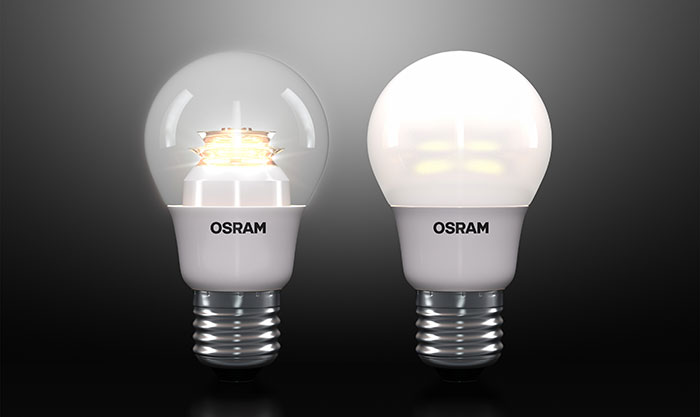Osram presents the first LED ”light bulb” made in Germany
 Other News
Other News Subscribe to newsletter
Subscribe to newsletter
| 4 Feb 2014 |
In anticipation of the "light+building" fair, Osram is today showing the very first LED incandescent lamp replacement produced by a major manufacturer in Germany. Unlike existing models, the 40 watt replacement is available in the same size of its predecessor.
As a further highlight for the world's leading lighting trade fair the company is also announcing an OLED that is on the heels of LED technology. In addition, Osram is showing an LED light engine that simplifies LED luminaire construction as well as a luminaire that generates an “artificial sky” in offices. The light+building lighting fair will be taking place from 30 March to 4 April in Frankfurt am Main, Germany.

Osram in the future will be manufacturing LED lamps in Germany in the typical bulb shape with E27 bases, and these will make up part of the wide-ranging LED lamp portfolio characterized by a highly integrated design language. Local production is part of the strategic approach of manufacturing LED lamps in proximity to their specific markets, for example in Europe for Europe.
A technological highlight of the lamp is its size: The 40 watt replacement will be just a small as its incandescent lamp equivalent, so that it fits into all luminaires previously equipped with standard light bulbs. The lamp with the name of "LED Superstar" is dimmable and its average lifespan is 25,000 hours.
OLED panel: Soon at the same level as LED
A further fair highlight is an OLED that enables luminaires with efficiency levels approaching LED technology. Efficiency is one of the essential factors that is helping OLED lighting to achieve its vital breakthrough. The new generation of the Orbeos OLED panel from Osram with 65 lumens per watt does not achieve the value of LED chips but is already more efficient than energy-saving lamps. In addition, LEDs require optics in luminaires that reduce glare and direct the light. These factors, depending on the quality of the luminaire, cost efficiency. If these are integrated into the calculation, the advantage for the light emitting diodes is actually less.
To gain a foretaste of the use of OLED in general lighting, Osram will be presenting an OLED luminaire at light+building designed by Werner Aisslinger, recently acclaimed "Designer of the Year 2014" buy the magazine Architektur & Wohnen. The suspended luminaire with a sophisticated appearance is equipped with 16 rectangular OLED panels. The luminaire demonstrates that OLED technology will not yet be found in open plan offices, but can certainly take on functional tasks, with particular suitability for use in conference rooms and hotel lobbies.
Prevaled Linear Flex: The LED "fluorescent lamp" that rolls out
Osram is presenting an LED light engine for luminaire manufacturers in the form of Prevaled Linear Flex that significantly cuts work effort for the assembly of LED luminaires and therefore their costs as well. The background is that at the moment, many luminaires are produced in two versions: one with fluorescent lamps and the other featuring LEDs. While fluorescent lamps are easily mounted to lampholders, LED assembly requires much greater effort, as several modules need to be screw-fastened because they are usually significantly shorter.
Prevaled Linear Flex solves this problem, being supplied on a 28 meter roll with shortening by the luminaire manufacturer to the desired length. It is then simply bonded into the luminaire for example. Assembly thus becomes similarly simple to its fluorescent lamp equivalent. Because of its pliable design, Prevaled Linear Flex also establishes new options for designing luminaires – for example organically-shaped luminaires with the high efficiency so typical for LEDs.
Arktika-P Biolux: Artificial sky for offices
Osram will be presenting an office luminaire at light+building in the form of Arktika-P Biolux that generates "artificial sky" in offices. The luminaire concept is based on the scientific recognition that a receptor in the eye is responsible for controlling our inner clock, and this receptor responds to light colours: the cooler light of the morning sky stimulates us while the warmer, less blue light of sunset allows us to calm down. Both are important so that we can sleep well at night and are up-and-running during the day.
The Arktika-P Biolux fetches the effects of daylight into offices. It directly illuminates the working plane and also indirectly the ceiling according to the time of day – with two different light colours and with individual control and dimming. Just as height-adjustable desks are good for our backs, the Arktika-P Biolux is good for our spirit, making sure that we approach our work in a concentrated way. The Arktika-P will be awarded this year's iF Design Award at the end of February, a highly renowned design prize.




